If you have ever manually moved a filestore from one site to another, or migrated a database without the filestore, then you’ve probably had to deal with failing or missing assets.
It’s not obvious how assets are stored and served within the Odoo system. There is no manual compilation
process like you would expect coming from frontend utilities like npm ,
webpack
, or even a simpler sass --watch process.
As developers, when we are writing stylesheets or javascript we just reload the page and everything has been minified and concatenated into these large asset bundles. Automagically. 🎆
I’m going to try to reveal a little bit of the magic going on behind the scenes and some tricks for regenerating assets bundles.
Viewing the bundles
Open up developer tools on any Odoo instance. In the <head/> you won’t see a ton of
link
or script tags from all of the different modules (assuming you are not in developer mode). You
will just see a few compiled files.
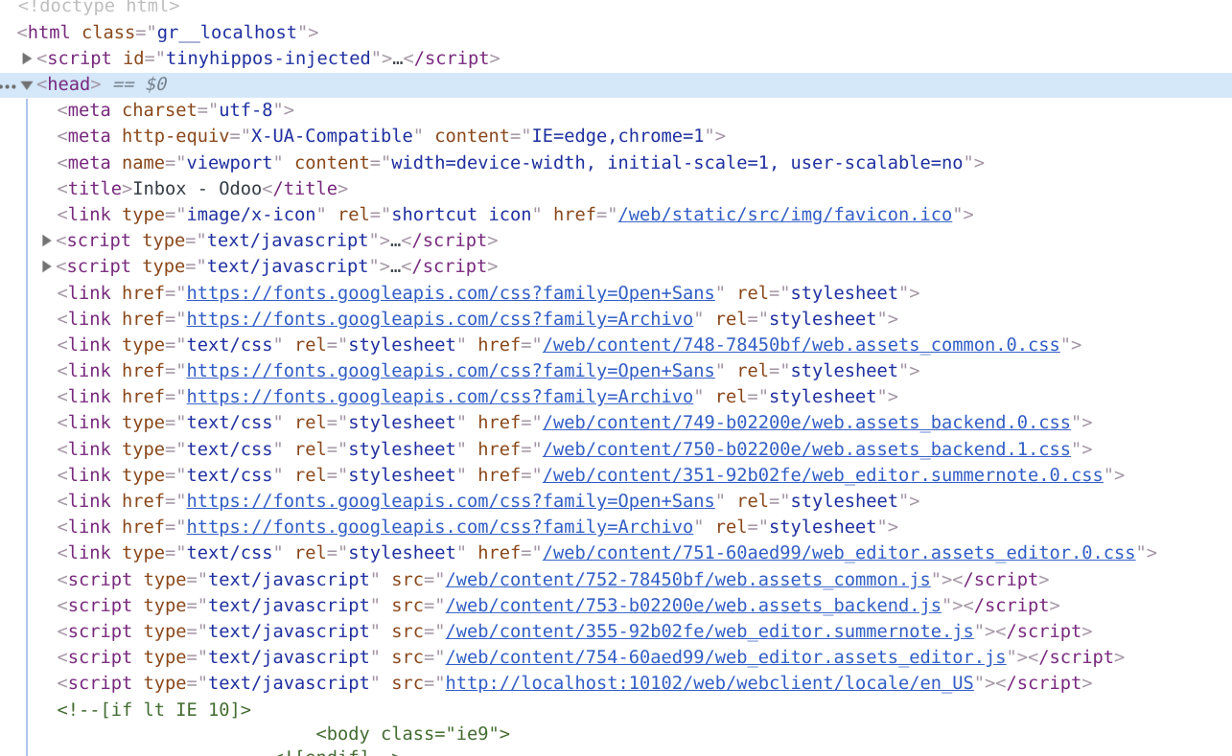
They are broken out into a few categories:
web.assets_commonweb.assets_backendweb_editor.summernoteweb_editor.assets_editor
And when you open up any of these files, they are an aggregated set of assets across multiple modules. They aren’t completely abstracted though. You can still see paths to where the assets came from.
This is how all of the assets are served up to Odoo when you are accessing the site as a normal, non-developer mode user. We’ll get into why these are like this, but as a developer, you should always expect the assets to be compiled into these large, minified files by default.
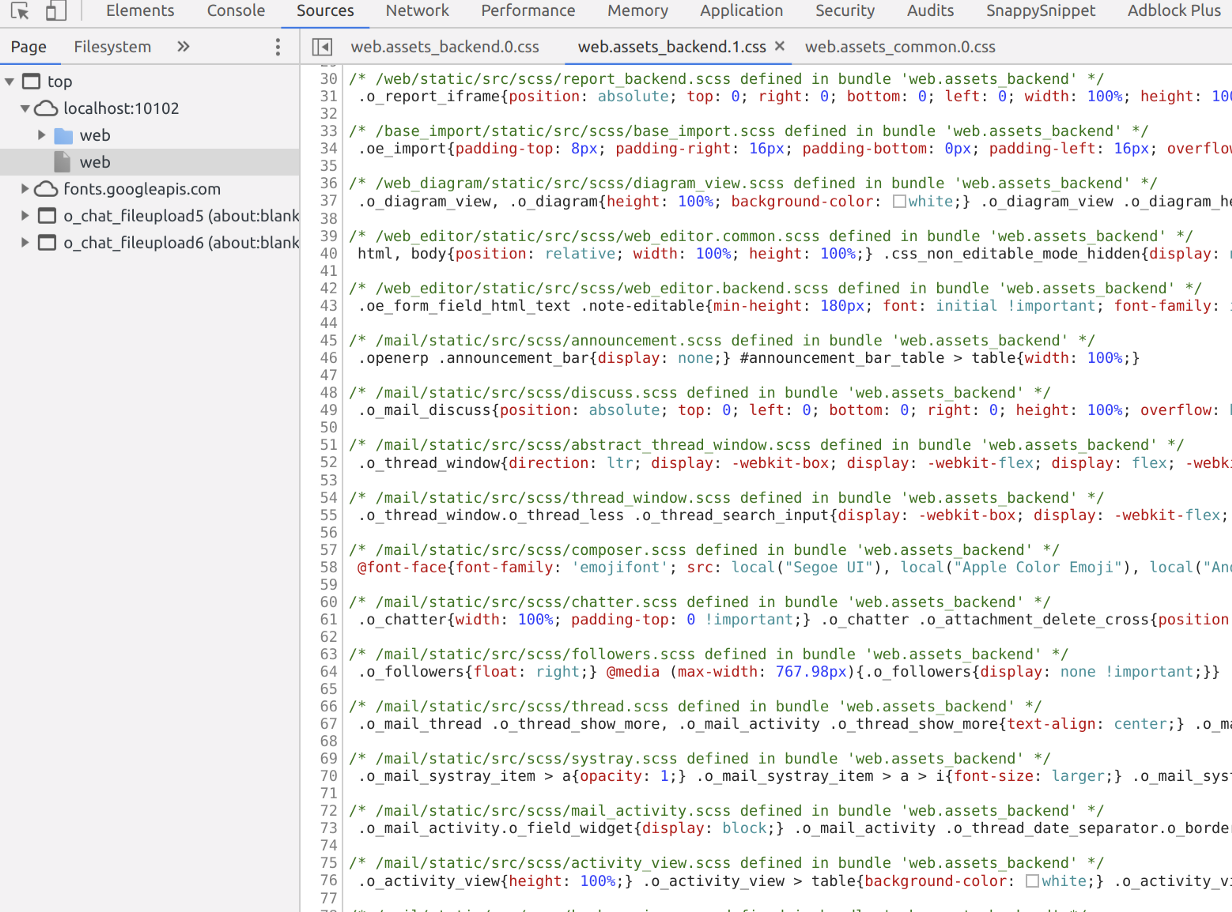
Why are assets bundled
I wasn’t in the room when the creators of Odoo decided to do this, but it’s most likely for performance and convenience.
Performance
Loading in hundreds and hundreds of assets files isn’t smart. Odoo isn’t a small application, so they concatenate everything together server side so that the client only has to load a few files. This makes things faster obviously. Fewer files and less content going over the network.
Convenience
There is a certain convenience about creating your module, defining your assets in xml, writing your css or js, reloading the page, and not having to worry about the bundling process at all. No file watchers, no extra commands to run.
I don’t completely agree with this approach because there’s too much “magic” and it’s not explicit to the developer what’s going on. If something is implicit then it needs to work 100% of the time. In the case of asset bundles, there are still scenarios where developers have to manually work with them (the reason I’m writing this article).
But I do understand the benefits to this approach, and as a developer as long as you are slightly aware of the inner working, then you’ll be able to handle any scenario.
Revealing a little bit more
Even though we open up dev tools and see all of those assets compiled, there are built-in utilities in Odoo for getting around that immediately.
This is where the difference between Developer Mode and Developer Mode with Assets comes in. I’m sure many users and even some developers have wondered why both of these modes exist.
Developer Mode leave the assets as is. They continue to perform their default process of concatenation and minification of all assets.
But we’re going to focus on Developer Tools with Assets. Let’s go ahead and enable is so that we can see exactly how it affects the asset bundling process. You can enable it one of two ways.:
- Go to Settings and select “Activate developer mode (with assets)”
- Or add
debug=assetsto your url parameters.
Now check out dev tools again:
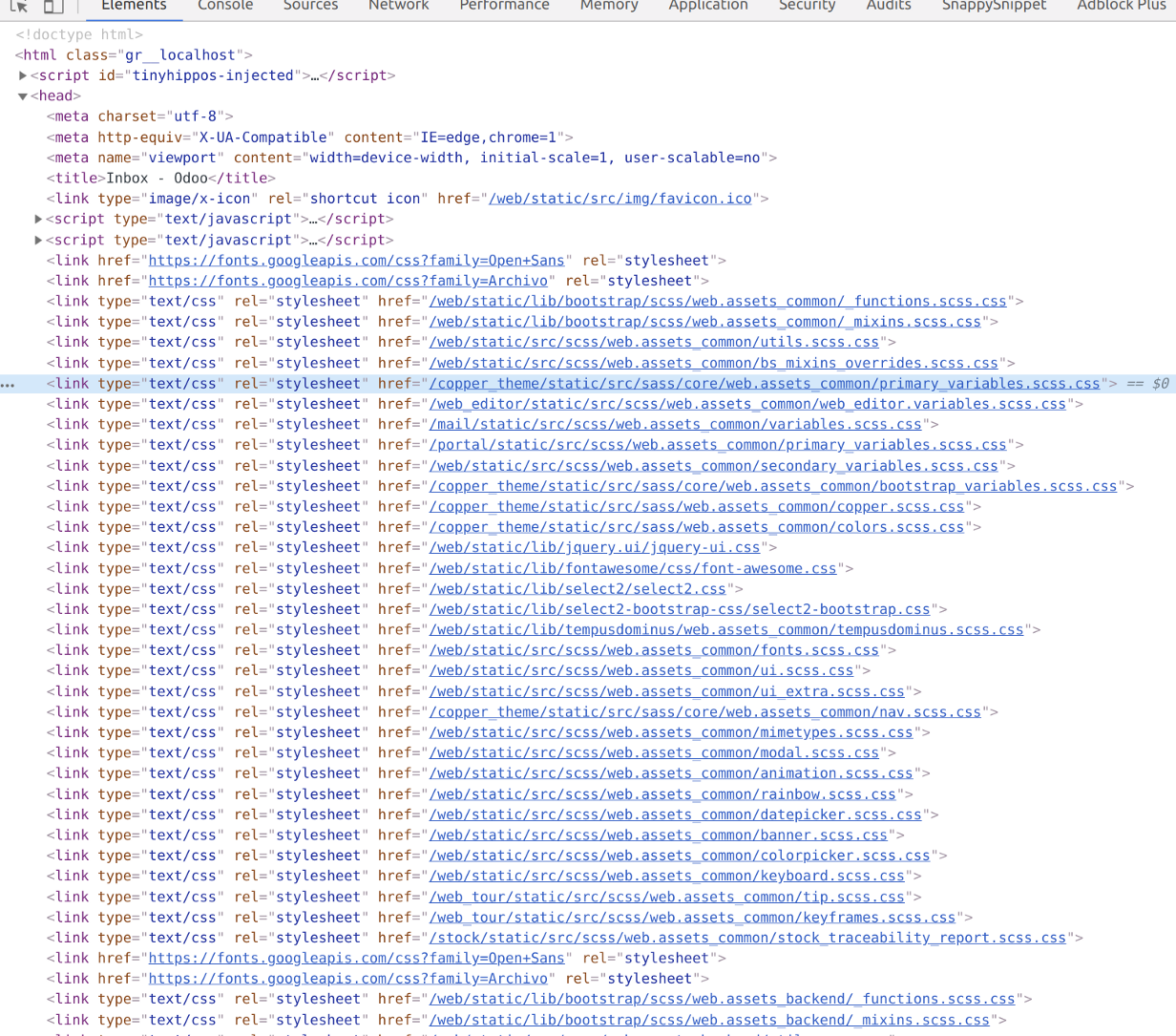
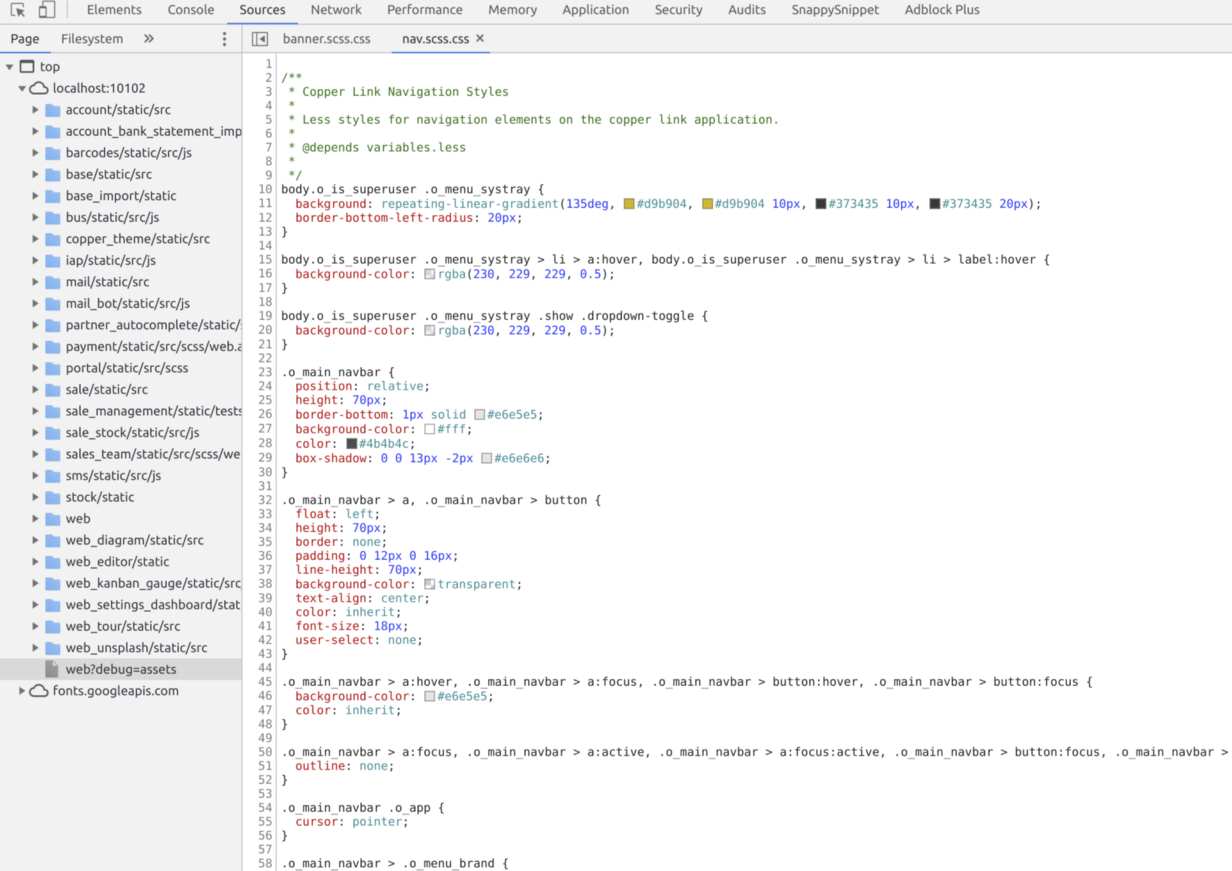
Nothing has been combined into a bundle. Frontend code has not been minified. We are actually now loading in every asset file manually. This obviously hurts performance but is very helpful as a developer. If we need to search css or js, find the original source files from core, extend core frontend code, etc. then we should be working with assets on.
Digging into core
Most developers probably understood what I explained above before they read this article. They know that
the assets get combined into large asset files like web.assets_backend from an xml template,
which they can inherit, stick their own <link/> or
<script/> tag in, and then their code gets included on the page.
But I would suspect most developers don’t understand the full process behind the scenes. If you start digging into core a bit, you can see how these are actually combined into bundles.
Attachments
ir.attachment becomes important since all of these bundles that you see on the frontend are stored
as attachment records.
Looking at the database, we can see the following records:
odoo=# select id,name from ir_attachment where name like '/web/content/%%assets_backend%.css%';
id | name
-----+---------------------------------------------------
749 | /web/content/749-b02200e/web.assets_backend.0.css
750 | /web/content/750-b02200e/web.assets_backend.1.css
(2 rows)
odoo=# select id,name from ir_attachment where name like '/web/content/%';
id | name
-----+---------------------------------------------------------
753 | /web/content/753-b02200e/web.assets_backend.js
754 | /web/content/754-60aed99/web_editor.assets_editor.js
681 | /web/content/681-875e871/web.assets_frontend.0.css
683 | /web/content/683-875e871/web.assets_frontend.js
748 | /web/content/748-78450bf/web.assets_common.0.css
749 | /web/content/749-b02200e/web.assets_backend.0.css
750 | /web/content/750-b02200e/web.assets_backend.1.css
751 | /web/content/751-60aed99/web_editor.assets_editor.0.css
752 | /web/content/752-78450bf/web.assets_common.js
351 | /web/content/351-92b02fe/web_editor.summernote.0.css
355 | /web/content/355-92b02fe/web_editor.summernote.js
(11 rows)
Looks familiar. We have all of the same files that we see in dev tools when loading up a page. All of
these bundles start with /web/content which makes it simple to search for.
We can even see the exact paths to these files in our filestore.
So we know that when the client makes the request to the frontend, Odoo is looking at those attachment
records, finding the file based on a path in the ir.attachment record, and then serving that file
to the frontend.
datas_fname | store_fname
--------------------------+-----------------------------------------
web.assets_backend.0.css | 13/1373c2eeb8edda69ac37a7ecfa5ba4a908fb94ba
web.assets_backend.1.css | 97/9733c7a9a67906f8ded8d8607155351d8d2881d1
(2 rows)
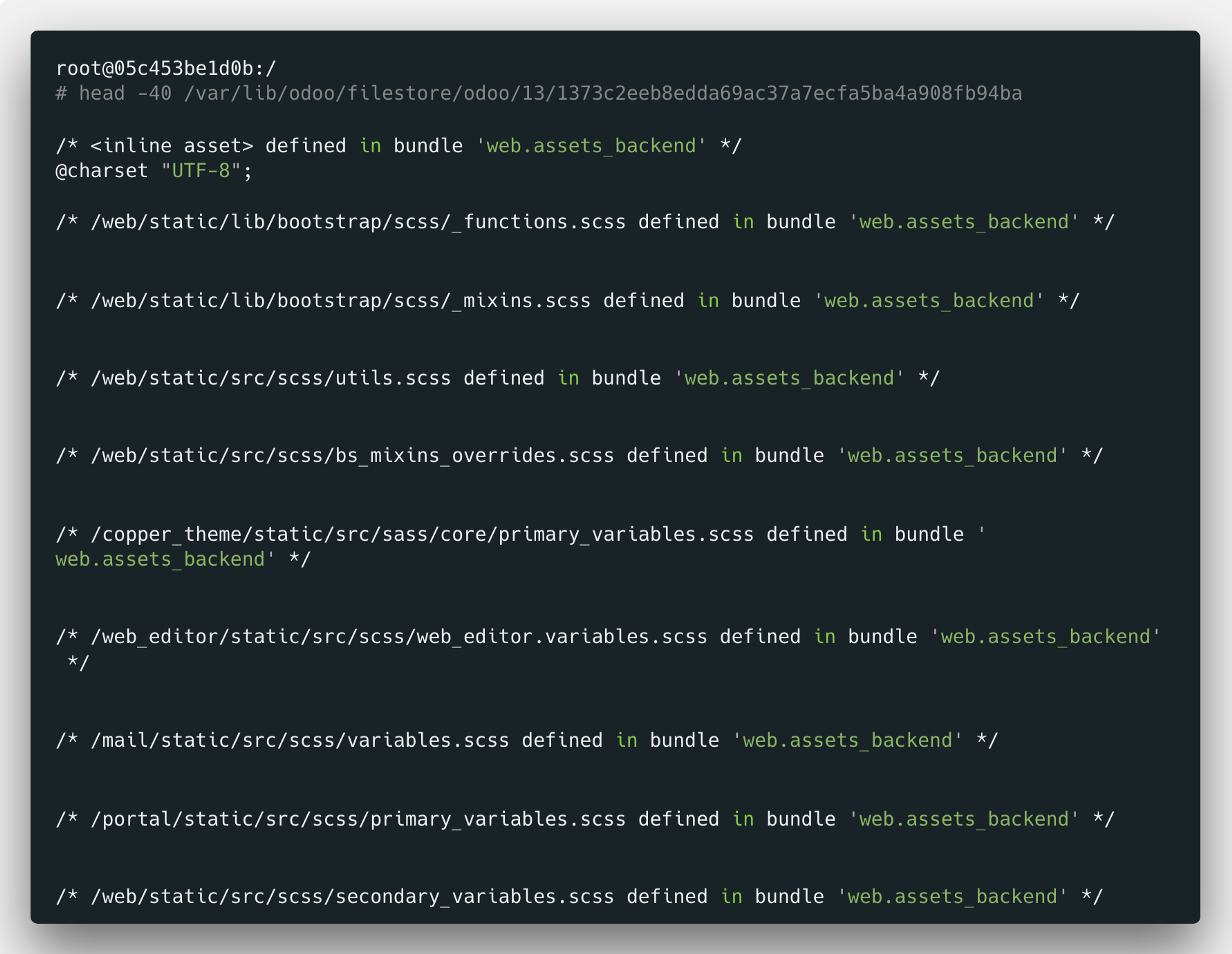
Asset creation and templates
So we know how assets are loaded, via ir.attachment but how do they actually get created? Like
I said earlier, automagically.
These are automatically generated, lazily, on page load.
<template id="web.webclient_bootstrap">
<t t-call="web.layout">
<t t-set="head_web">
<t t-call-assets="web.assets_common" t-js="false"/>
<t t-call-assets="web.assets_backend" t-js="false"/>
</t>
...
</t>
</template>
If you take a look at the web.webclient_bootstrap template, you will see those bundles being
loaded via the t-call-assets directive. This directive is the main function that looks at the
assets and auto creates them.
from odoo import models
from odoo.addons.base.models.qweb import QWeb
from odoo.addons.base.models.assetsbundle import AssetsBundle
class IrQWeb(models.AbstractModel, QWeb):
def _compile_directive_call_assets(self, el, options):
"""
This special 't-call' tag can be used in order to aggregate/minify
javascript and css assets.
This function makes a call to '_get_asset_nodes'.
"""
...
def _get_asset_nodes(
self,
xmlid,
options,
css=True,
js=True,
debug=False,
async_load=False,
values=None
):
"""
The purpose of this function is to aggregate all of the assets together
before generating a bundle. This called 'get_asset_bundle' to actually
generate the asset bundle.
"""
...
def get_asset_bundle(self, xmlid, files, remains=None, env=None):
return AssetsBundle(xmlid, files, remains=remains, env=env)
The IrQweb class is the one responsive for defining the
_compile_directive_call_assets
method. This method is linked to the xml t-call-assets directive. Check out the method
yourself in core, because it does a lot but in terms of asset generation, the most important part of the
method is that it calls _get_asset_nodes which then calls
get_asset_bundle .
You can see that get_asset_bundle references the primary class
AssetsBundle which is in charge of creating, updating, destroying, and generally managing the
asset bundles that we’ve been looking at.
AssetsBundle is another class that you should take a look at yourself to see all of the
different functionality provided. But the main function that we are going to look at is
save_attachment .
class AssetsBundle(object):
def save_attachment(self, type, content):
assert type in ('js', 'css')
ira = self.env['ir.attachment']
# Set user direction in name to store two bundles
# 1 for ltr and 1 for rtl, this will help during cleaning of assets bundle
# and allow to only clear the current direction bundle
# (this applies to css bundles only)
fname = '%s%s.%s' % (self.name, '' if inc is None else '.%s' % inc)
mimetype = 'application/javascript' if type == 'js' else 'text/css'
values = {
'name': "/web/content/%s" % type,
'datas_fname': fname,
'mimetype': mimetype,
'res_model': 'ir.ui.view',
'res_id': False,
'type': 'binary',
'public': True,
'datas': base64.b64encode(content.encode('utf8')),
}
attachment = ira.sudo().create(values)
url = self.get_asset_url(
id=attachment.id,
unique=self.version,
extra='%s' % ('rtl/' if type == 'css' and self.user_direction == 'rtl' else ''),
name=fname,
page='',
type='',
)
values = {
'name': url,
'url': url,
}
attachment.write(values)
if self.env.context.get('commit_assetsbundle') is True:
self.env.cr.commit()
self.clean_attachments(type)
return attachment
The save_attachment method creates ir.attachment records based on binary strings
generated from bundled content passed in. You will notice that these are always prefixed with
/web/content
which is why we can search ir.attachment records based on /web/content when looking
for bundles generated from core.
The details
There are more details that occur between the XML directive and the save_attachment method so
I highly recommend going through the methods to learn a little bit more about the actual concatenation and
minification process. That’s out of scope of this article :)
The case for regenerating bundles
Before getting into the process of actually regenerating the bundles, let’s review the scenarios when bundles need to be regenerated. It’s not too often, depending on what you do day-to-day.
- Migrating a filestore manually to a separate instance, via an
scp,ftp, or even just amvtransfer. - Restoring a database from a sql dump without the filestore.
- Corrupted assets.
How to regenerate assets from the GUI
If are on Odoo 12.0+ then regenerating asset bundles is simple from the GUI (assuming that you can access the GUI.)
- Enable developer mode
- Open the debug menu from the toolbar
- Select Regenerate Asset Bundles
This runs a JS function called regenerateAssets .
/**
* Delete asset bundles to force their regeneration.
*
* @returns {void}
*/
regenerateAssets: function () {
var self = this;
var domain = [
['res_model', '=', 'ir.ui.view'],
['name', 'like', 'assets_'],
];
this._rpc({
model: 'ir.attachment',
method: 'search',
args: [domain],
}).then(function(ids) {
self._rpc({
model: 'ir.attachment',
method: 'unlink',
args: [ids],
}).then(self.do_action('reload'));
});
}
How to regenerate assets from Odoo Shell
Looking at the JS function above, it’s not too difficult for us to just manually regenerate the assets ourselves from an Odoo shell instance. If you are on Odoo 11.0 or prior, then this is very helpful since you don’t have the GUI functions provided in 12.0+.
After deleting the ir.attachment records then you just need to reload the web page, which
will call the t-call-assets directive again and regenerate the bundles. Once the page is loaded
you can look in the database and see that all of those attachments you just deleted are back.
In [1]: domain = [('res_model', '=', 'ir.ui.view'), ('name', 'like', 'assets_')]
In [2]: env['ir.attachment'].search(domain).unlink()
Out[2]: True
In [3]: env.cr.commit()
How to regenerate assets from psql
And finally, we can do the same thing from a psql prompt as well.
The same applies here as when regenerating from Odoo shell. Reload the web page and the system will recreate the asset bundle attachments.
odoo=# select id,name from ir_attachment where res_model='ir.ui.view' and name like '%assets_%';
id | name
-----+---------------------------------------------------
879 | /web/content/879-78450bf/web.assets_common.0.css
880 | /web/content/880-78450bf/web.assets_backend.0.css
881 | /web/content/881-78450bf/web.assets_backend.1.css
882 | /web/content/882-78450bf/web_editor.assets_editor.0.css
883 | /web/content/883-78450bf/web.assets_common.js
884 | /web/content/884-78450bf/web.assets_backend.js
885 | /web/content/885-78450bf/web_editor.assets_editor.js
(7 rows)
odoo=# delete from ir_attachment where res_model='ir.ui.view' and name like '%assets_%';
DELETE 7
Thanks For Reading
I appreciate you taking the time to read any of my articles. I hope it has helped you out in some way. If you're looking for more ramblings, take a look at theentire catalog of articles I've written. Give me a follow on Twitter or Github to see what else I've got going on. Feel free to reach out if you want to talk!
